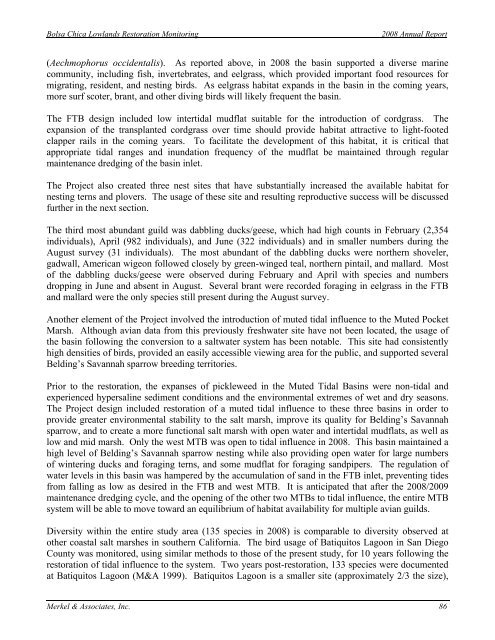2008 Annual Monitoring Report (pdf 10.9MB) - Bolsa Chica ...
2008 Annual Monitoring Report (pdf 10.9MB) - Bolsa Chica ...
2008 Annual Monitoring Report (pdf 10.9MB) - Bolsa Chica ...
Create successful ePaper yourself
Turn your PDF publications into a flip-book with our unique Google optimized e-Paper software.
<strong>Bolsa</strong> <strong>Chica</strong> Lowlands Restoration <strong>Monitoring</strong><br />
<strong>2008</strong> <strong>Annual</strong> <strong>Report</strong><br />
(Aechmophorus occidentalis). As reported above, in <strong>2008</strong> the basin supported a diverse marine<br />
community, including fish, invertebrates, and eelgrass, which provided important food resources for<br />
migrating, resident, and nesting birds. As eelgrass habitat expands in the basin in the coming years,<br />
more surf scoter, brant, and other diving birds will likely frequent the basin.<br />
The FTB design included low intertidal mudflat suitable for the introduction of cordgrass. The<br />
expansion of the transplanted cordgrass over time should provide habitat attractive to light-footed<br />
clapper rails in the coming years. To facilitate the development of this habitat, it is critical that<br />
appropriate tidal ranges and inundation frequency of the mudflat be maintained through regular<br />
maintenance dredging of the basin inlet.<br />
The Project also created three nest sites that have substantially increased the available habitat for<br />
nesting terns and plovers. The usage of these site and resulting reproductive success will be discussed<br />
further in the next section.<br />
The third most abundant guild was dabbling ducks/geese, which had high counts in February (2,354<br />
individuals), April (982 individuals), and June (322 individuals) and in smaller numbers during the<br />
August survey (31 individuals). The most abundant of the dabbling ducks were northern shoveler,<br />
gadwall, American wigeon followed closely by green-winged teal, northern pintail, and mallard. Most<br />
of the dabbling ducks/geese were observed during February and April with species and numbers<br />
dropping in June and absent in August. Several brant were recorded foraging in eelgrass in the FTB<br />
and mallard were the only species still present during the August survey.<br />
Another element of the Project involved the introduction of muted tidal influence to the Muted Pocket<br />
Marsh. Although avian data from this previously freshwater site have not been located, the usage of<br />
the basin following the conversion to a saltwater system has been notable. This site had consistently<br />
high densities of birds, provided an easily accessible viewing area for the public, and supported several<br />
Belding’s Savannah sparrow breeding territories.<br />
Prior to the restoration, the expanses of pickleweed in the Muted Tidal Basins were non-tidal and<br />
experienced hypersaline sediment conditions and the environmental extremes of wet and dry seasons.<br />
The Project design included restoration of a muted tidal influence to these three basins in order to<br />
provide greater environmental stability to the salt marsh, improve its quality for Belding’s Savannah<br />
sparrow, and to create a more functional salt marsh with open water and intertidal mudflats, as well as<br />
low and mid marsh. Only the west MTB was open to tidal influence in <strong>2008</strong>. This basin maintained a<br />
high level of Belding’s Savannah sparrow nesting while also providing open water for large numbers<br />
of wintering ducks and foraging terns, and some mudflat for foraging sandpipers. The regulation of<br />
water levels in this basin was hampered by the accumulation of sand in the FTB inlet, preventing tides<br />
from falling as low as desired in the FTB and west MTB. It is anticipated that after the <strong>2008</strong>/2009<br />
maintenance dredging cycle, and the opening of the other two MTBs to tidal influence, the entire MTB<br />
system will be able to move toward an equilibrium of habitat availability for multiple avian guilds.<br />
Diversity within the entire study area (135 species in <strong>2008</strong>) is comparable to diversity observed at<br />
other coastal salt marshes in southern California. The bird usage of Batiquitos Lagoon in San Diego<br />
County was monitored, using similar methods to those of the present study, for 10 years following the<br />
restoration of tidal influence to the system. Two years post-restoration, 133 species were documented<br />
at Batiquitos Lagoon (M&A 1999). Batiquitos Lagoon is a smaller site (approximately 2/3 the size),<br />
Merkel & Associates, Inc. 86






